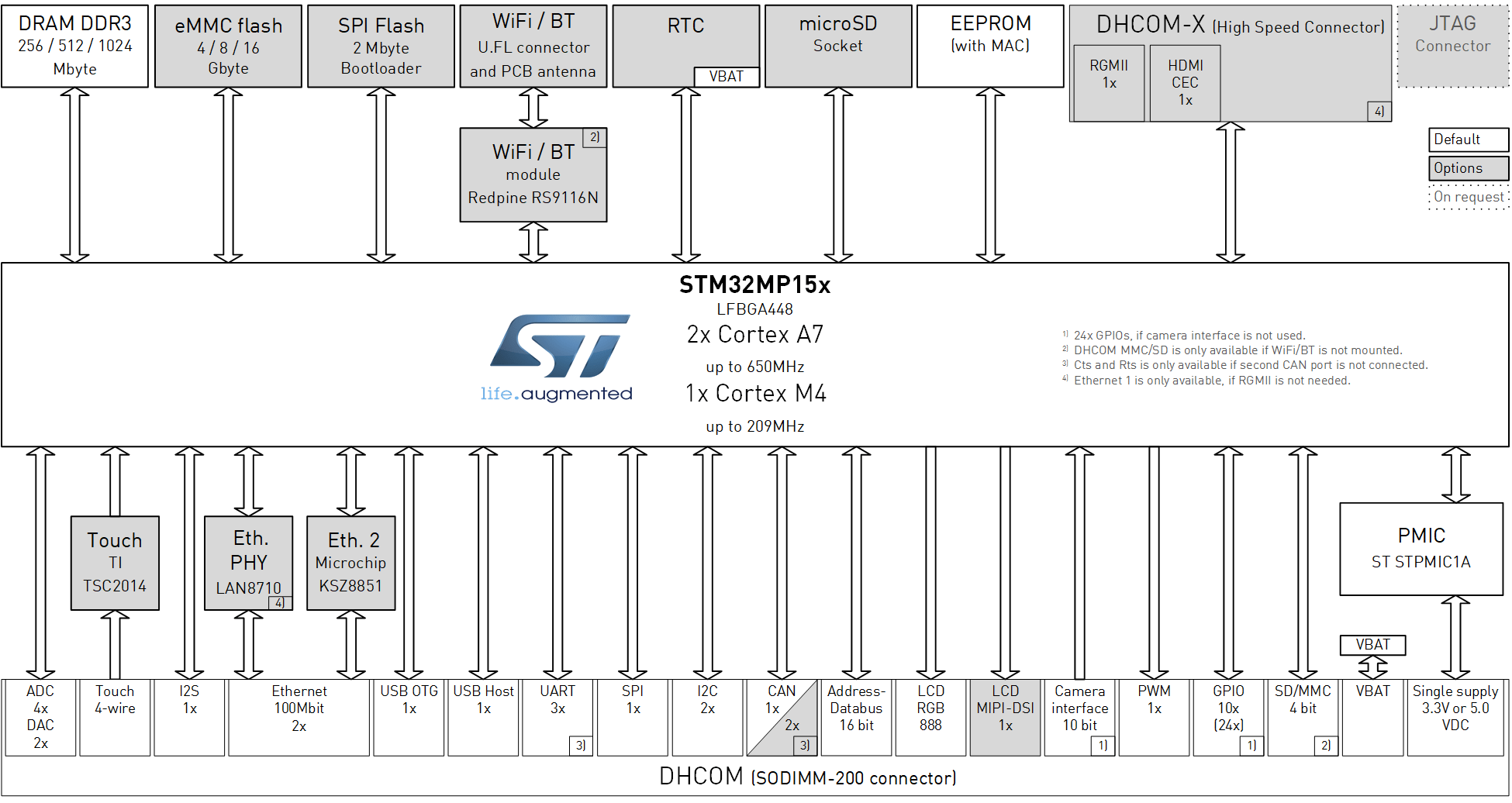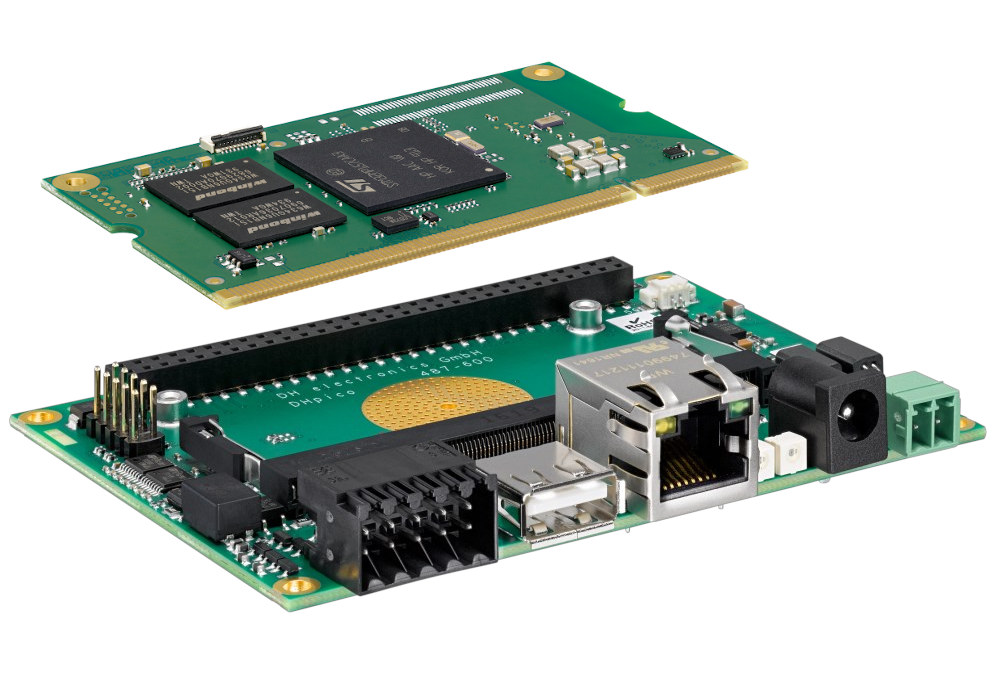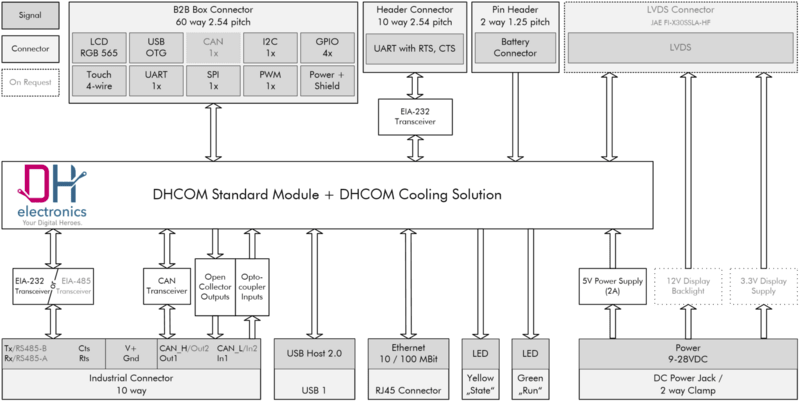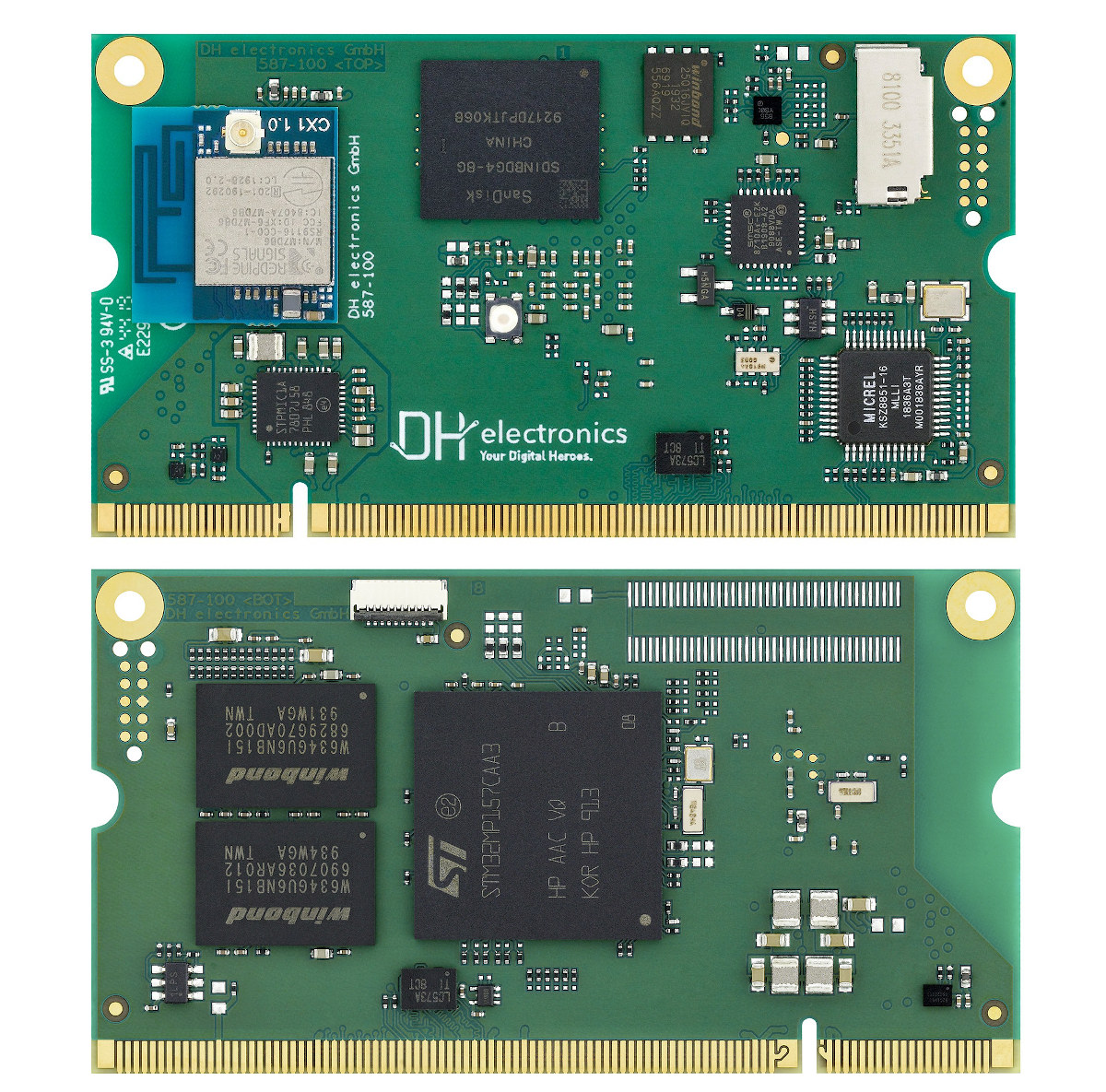DH electronics DHCOM STM32MP1 is an STMicro STM32MP1 Cortex-A7/M4 system-on-module (SoM) following the company’s SO-DIMM-based DHCOM standard, and capable of running Linux with Etnaviv GPU drivers.
The SoM is compatible with two DHCOM carrier boards from the company, namely DH PDK (Premium Developer Kit) for development, and DH PicoITX2 Pico-ITX board for direct integration into products.
DHCOM STM32MP1 SoM
DHCOM STM32MP1 specifications:
- SoC – STMicro STM32MP15x with up to two Arm Cortex-A7 core up to 650 MHz, one Arm Cortex-M4 up to 209 MHz, Vivante 3D GPU @ up to 533 MHz with OpenGL ES 2.0 support
- System Memory – 256, 512, or 1024 MB 32-bit DDR3 DRAM
- Storage
- 4, 8, or 16 GB eMMC flash
- 2 MB boot flash
- 256 bytes EEPROM
- MicroSD card socket on module
- Connectivity – WiFi 4 IEEE 802.11 a/b/g/n, 802.11j (hosted mode) with dual band, Bluetooth 5.0 (BR/EDR/BLE), PCB antenna and U.FL antenna connector
- SODIMM-200 edge connector
- Bus interface – 16-bit asynchronous address/data bus, 1 CS
- Storage – 4-bit MMC/SD interface
- Display
- 24-bit RGB interface for displays up to 1366 x 768 resolution
- 2-lane MIPI-DSI up to 1 GHz each
- 4-wire touch interface
- Camera – 10-bit parallel camera interface up to 140 MB/s
- Audio – 1x I2S
- Ethernet – 1x 10/100 Mbit Ethernet with IEEE 1588v2, 1x 10/100 Mbit
- USB – 1x USB host, 1x USB OTG
- Serial – 2x CAN bus (V2.0B + FD V1.0), 3x UART up to 12.5 Mbps (1x Tx/Rx, 2x Tx/Rx/Rts/Cts)
- 1x SPI, 2x I2C up to 1 Mbit/s, 24x GPIO, 16-bit PWM
- 4x 16 bit ADC, and 2x 12 bit DAC
- Security – TrustZone, cryptography, hash, secure boot
- Misc – RTC, JTAG interface on module
- Power
- Supply Voltage – 3.3 or 5.0 VDC / typ. 1 W-1.5 W (without WiFi/BT)
- STPMIC1A Power Management IC
- Dimensions – 67.6 x 36.7 x 8.1 mm
- Temperature range – -40 to +85 °C

Note some of the interfaces are multiplexed, so click on the image above to enlarge it, and get more details about which interface can not be used at the same time such as MMC/SD and WiFi/Bt.
The company provides a Linux BSP with Debian and Yocto support, and there’s a short Wiki to get started. I found out about the module because it is listed in Linux 5.11 changelog, so that means it should also run mainline Linux together with Etnaviv open-source graphics drivers.
DH PicoITX2 Pico-ITX carrier board
 DHCOM STM32MP1 SoM can be combined with DH Electronics’s DH PicoITX2 carrier board to create an STM32MP1 Pico-ITX SBC with the following key features and specifications:
DHCOM STM32MP1 SoM can be combined with DH Electronics’s DH PicoITX2 carrier board to create an STM32MP1 Pico-ITX SBC with the following key features and specifications:
- Supported SoM – DHCOM modules based on STM32MP1, NXP i.MX or Texas Instruments Sitara AM33xx processor
- Display
- 1x 24-bit RGB display interface, or on-request, single-channel 24-bit LVDS with display and backlight supply
- 4-wire resistive touch interface
- Connectivity – 10/100M Ethernet RJ45 port
- USB – 1x Host 2.0, 1x OTG 2.0
- Serial
- 1x RS232 (Rx / Tx / Rts / Cts), 1x RS232 (Rx / Tx / Rts / Cts) or RS485, 1x UART (Rx / Tx)
- CAN – 1 x CAN (up to 1MBaud) or CAN (without Transceiver)
- Low-speed I/Os – 1x I2C, 1x SPI, 16-bit PWM, 4x GPIOs
- Inputs – 1x Opto-coupler (optional additional Input alt. to CAN)
- Outputs – 1x Open Collector (optional additional Output alt. to CAN)
- Misc – Various LEDs, Connector for CR2032
- Power supply – 9 to 28 VDC
- Dimensions – 100 x 72 x 18 mm (Pico-ITX form factor)
- Temperature range – 40 to +85 °C

You may wonder what’s the yellow circle in the center of the carrier board is for. That’s not to make the board pretty, but instead, it’s the company’s “5-cent cooling solution”:
… It got its name from the round copper surface. Coupled with a gap pad, its copper surface dissipates the heat from the processor into the inner layers of the circuit board using thermal vias. There, the heat is distributed evenly over the carrier board and is mostly dissipated to the environment by convection and heat radiation. The even heat distribution protects the remaining components from overheating.
Another option for using the 5-Cent Cooling Solution is the direct conduction of the CPU heat to the housing of the product. In this case the heat is passed through from the thermal vias to the housing using an additional gap pad. This ensures even lower CPU temperatures and eliminates the need for a heat sink even with greater thermal power dissipation.
Typical applications for the STM32MP1 module and Pico-ITX board include industrial automation, machine controls and operator panels (HMI), home & building automation, and medical technology.
Pricing is not available publicly, but you can find more information and/or request a quote on the product pages for the module and carrier board.

Jean-Luc started CNX Software in 2010 as a part-time endeavor, before quitting his job as a software engineering manager, and starting to write daily news, and reviews full time later in 2011.
Support CNX Software! Donate via cryptocurrencies, become a Patron on Patreon, or purchase goods on Amazon or Aliexpress. We also use affiliate links in articles to earn commissions if you make a purchase after clicking on those links.





Did the concept of SOM every pay off? Thereare so many different connection types and either the base board os limiting or costs too much for no benefit.
The often cited benefit of just swapping the module to keep your product up to date hardly ever seems to work out.
The only reason for a SOM to exist is the fact that many developers shy away from complex Z-matched routing, BOM sourcing in small quantities as well as soldering/reworking BGA and similar.
For any other reason a “soft SOM” (=pre routed block to paste into the baseboard’s layout) makes more sense.
I think SoMs like this are used a lot in industrial stuff where the main PCB is some massive 2 or 4 layer board with heavy copper and the high profit margin and low volume doesn’t justify spinning a custom module for an SoC.